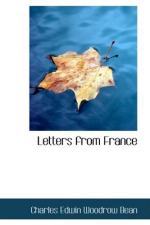That is the country in which our boys are fighting the greatest battle Australians have ever fought. Of the men whom you find there, what can one say? Steadfast until death, just the men that Australians at home know them to be; into the place with a joke, a dry, cynical, Australian joke as often as not; holding fast through anything that man can imagine; stretcher bearers, fatigue parties, messengers, chaplains, doing their job all the time, both new-joined youngsters and old hands, without fuss, but steadily, because it is their work. They are not heroes; they do not want to be thought or spoken of as heroes. They are just ordinary Australians doing their particular work as their country would wish them to do it. And pray God Australians in days to come will be worthy of them!
CHAPTER XVII
POZIERES RIDGE
France, August 14th.
You would scarcely realise it from what the world has heard, but I think that the hardest battle ever fought by Australians was probably the battle of Pozieres Ridge.
There have been four distinct battles fought by the Australian troops on the Somme since they made their first charge from the British trenches near Pozieres. The first was the heavy three days’ fight by which they took Pozieres village. The second was the fight in which they tried to rush the German second line along the hill-crest behind Pozieres. The third was the attack in which this second line was broken by them along a front of a mile and a half. The fourth has been the long fight which immediately began along the German second line northwards from the new position, along the ridge towards Mouquet Farm. It has been hard fighting all the way, and what was three weeks ago a German salient into the British line is now a big Australian salient into the German line. But I think that the hardest fight of all was that of the second and third phases—the battle for Pozieres Ridge.
Pozieres village itself was not on the crest of the hill. It was on the British side of it, where the German was naturally hanging on because it was almost the highest point in his position and gave him a view over miles of our territory. On the other hand, the German main second line behind Pozieres was practically on the summit; in some parts farther north it was actually on or just over the summit. It was from two to seven hundred yards beyond the village itself.




